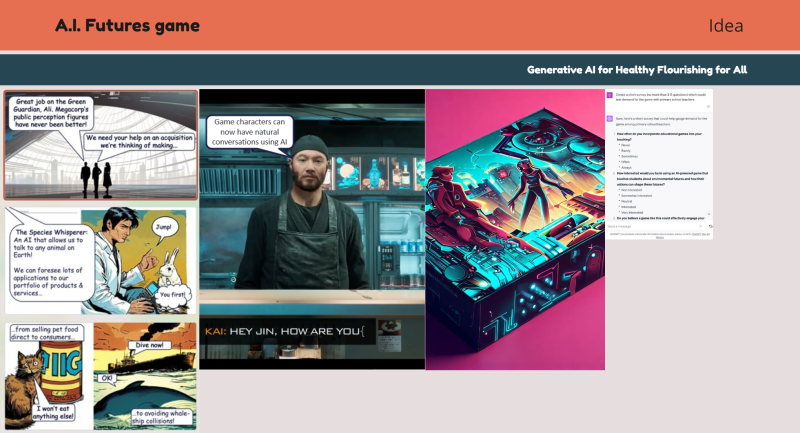Mary Stevens26 Aug 2023
“Our climate destiny won’t be decided in boardrooms, or parliaments, in the financial markets, or even on the streets. It will be decided in the story which we, humanity, tells ourselves, about ourselves.”
The power of storytelling to shape our future is the key message of a recent report by Futerra, (Stories to Change the World) drawing on the Intergovernmental Panel on Climate Change’s 2022 report which notes: “Narratives enable people to imagine and make sense of the future through processes of interpretation, understanding, communication and social interaction.”
Artificial intelligence (AI), like climate change, is a great accelerator. It has the potential to turbo-charge all the existing inequalities of our extractive model of capitalism. But unlike climate breakdown, where the ‘lag effect’ means some of the consequences of rising global temperatures are already baked in, there is nothing given about AI.
Who makes decisions about the future of AI?
For now, the future trajectory of the technology is entirely a matter of other humans - in tech corporations and governments - making decisions about our futures. And they are rapidly establishing a narrative: AI is synonymous with progress, it’s inevitable, and there’s nothing we can do to stop it. We can only establish a few safeguards to mitigate the worst possible harms - imagined as somewhere in the future - rather than already here. And when it comes to the application of AI there’s a secondary story, one that builds on the stories we have been telling ourselves about cloud-based computing for the last two decades: these technologies are abstract and exist only in the parallel universe of cyberspace. For the shiny story of progress is dependent on an organized forgetting – of the outsourced labour, physical infrastructure and resource use behind every ChatGPT-generated video or text.
Shaping a different story
If we want to create a different kind of future, we need to find powerful ways to tell different stories. Above all, to do justice to those most impacted by these developments, we need to make the invisible visible. In our recent lab we looked for ‘leverage points’. Using Donella Meadow’s iceberg model of levers, which we explored together, we see that intervening at the level of mental models can be one of the most effective places to act - but also the level where it can take longest to register the impacts. We are not the only people to be drawing this conclusion. It drives the work of the AINow Institute (which aims to “set the bar for discourse-shaping work that focuses on the social consequences of AI and the industry behind it”) and in the UK, the Future Narratives Lab has recently produced a messaging guide for and with the New Economy Organisers Network on how to shape the political story around artificial intelligence.
Our ideas for sharing the new stories
So how in practice to we start to get an alternative story out there? What’s the medium as well as the message? We began to explore some creative suggestions in our lab.
- A competition or fund for artist-technologist collaborations. We are not storytelling specialists or tech experts. We don’t know what video, interactive installation or publication will work best. But what if funding were available for a series of artist-technologist collaborations with a brief to tell the hidden stories (about inequality, labour impacts and resource use). The recent Grounding Technologies programme from the Pervasive Media Studio is a good example. King’s College London already has an exhibition focused on exploring more unusual applications and stimulating ‘contemplation and curiosity’. But what if a similar brief were more explicitly focused on power, inequality and alternative future scenarios? On making the invisible – structures of control, wealth, exploitation – visible?
- An Artificial Intelligence Futures Game. Nothing about the future is inevitable. So what if we explored this proposition through a game, playable in schools and colleges (but perhaps also available for communities) that could offer different choices – and perhaps supported by an AI assist that allowed the game to evolve based on the choices made by previous participants? Versions of this already exist (for example this role play game), but what if the model were more like Climate Fresk (i.e. a much-distributed facilitator network) or even self-supporting? Or could it draw inspiration from this Nesta Futures Game, but perhaps build something more immersive?
- Visualiser plug-in showing the impacts of each search. Sust.earth is a plug-in for fashion sites that tells you about the ethical scores of fashion products and suggests similar pre-loved items as well as actions you can take to raise concerns with brands. What if something similar existed for generative AI? And what if it were not just factual but also creative and beautiful, a bit like the Forest app for focus time? So that with every search – or every interaction with an AI-generated output – we would see the impact we are having and the more beautiful world that regenerative technologies might be able to grow?
Work with us?
These are just some of our emerging ideas. As with the others in this series, we don’t currently have the resources or capacity to lead on these proposals, or do this work alone, but we would love to understand where there might be the energy and the financial backing to bring these ideas to life.
We know that the challenge of changing the narrative could inspire all sorts of other visions. If you want to use storytelling to change the narrative and want to work with us to find ways to resource and develop this work – we can’t do it without partners – we'd love to hear from you.
This is the fourth in blog post from a series of four, exploring the outputs from our recent design lab. Mary Stevens explores the opportunities for changing the narrative about AI. If you are interested in collaborating on any of these ideas please get in touch at [email protected]


